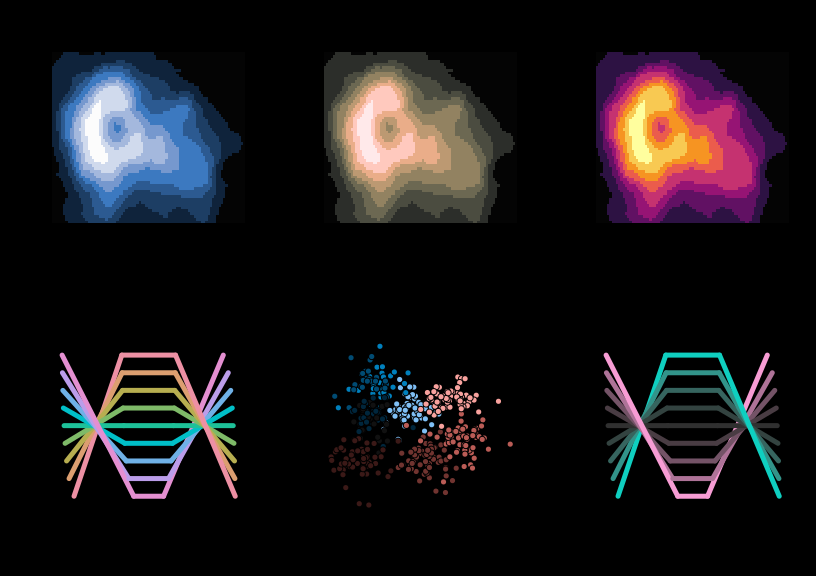Palette Visualization and Assessment
palette_visualization.RmdOverview
The colorspace package provides several visualization functions for depicting one or more color palettes and their underlying properties. Color palettes can be visualized by:
-
swatchplot(): Color swatches. -
specplot(): Spectrum of HCL and/or RGB trajectories. -
hclplot(): Trajectories in 2-dimensional HCL space projections. -
demoplot(): Illustrations of typical (and simplified) statistical graphics.
Color swatches
The function swatchplot() is a convenience function for
displaying collections of palettes that can be specified as lists or
matrices of hex color codes. Essentially, it is just a call to the base
graphics rect() function but with heuristics for choosing
default labels, margins, spacings, borders, etc. These heuristics are
selected to work well for hcl_palettes() and might need
further tweaking in future versions of the package.
As a first simple example, the properties of the three HCL axes are brought out by varying only one coordinate while keeping the other two fixed:
swatchplot(
"Hue" = sequential_hcl(5, h = c(0, 300), c = c(60, 60), l = 65),
"Chroma" = sequential_hcl(5, h = 0, c = c(100, 0), l = 65, rev = TRUE, power = 1),
"Luminance" = sequential_hcl(5, h = 260, c = c(25, 25), l = c(25, 90), rev = TRUE, power = 1),
off = 0
)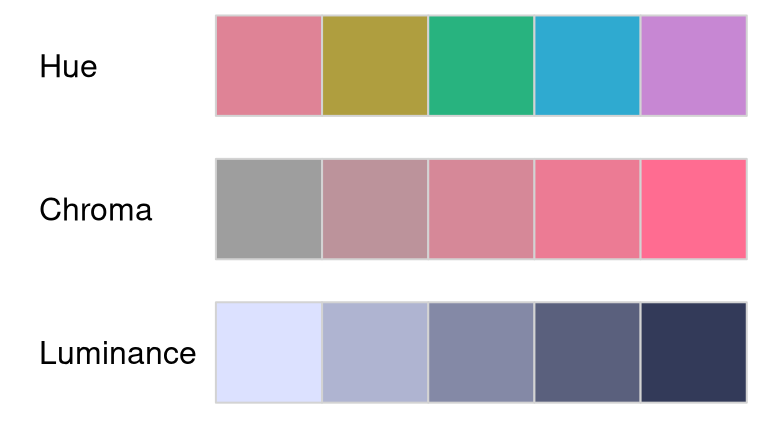
This shows the following:
- Hue: Only the hue (= type of color) changes from H = 0 (red) via 60 (yellow), etc. to 300 (purple) while chroma and luminance are fixed to moderate values of C = 60 and L = 65, respectively.
- Chroma: Only the chroma (= colorfulness) changes from C = 0 (gray) to 100 (colorful) while hue and luminance are fixed to H = 0 (red) and L = 65, respectively.
- Luminance: Only the luminance (= brightness) changes from L = 90 (light) to 25 (dark) while hue and chroma are fixed to H = 260 (blue) and C = 25 (low, close to gray), respectively.
Next, we demonstrate a more complex example of a
swatchplot() with three matrices of sequential color
palettes of blues, purples, reds, and greens. For all palettes,
luminance increases monotonically to yield a proper sequential palette.
However, the hue and chroma handling is somewhat different to emphasize
different parts of the palette.
- Single-hue: In each palette the hue is fixed and chroma decreases monotonically (along with increasing luminance). This is typically sufficient to clearly bring out the extreme colors (dark/colorful vs. light gray).
- Single-hue (advanced): The hue is fixed (as above) but the chroma trajectory is triangular. Compared to the basic single-hue palette above, this better distinguishes the colors in the middle and not only the extremes.
- Multi-hue (advanced): As in the advanced single-hue palette, the chroma trajectory is triangular but additionally the hue varies slightly. This can further enhance the distinction of colors in the middle of the palette.
bprg <- c("Blues", "Purples", "Reds", "Greens")
swatchplot(
"Single-hue" = t(sapply(paste(bprg, 2), sequential_hcl, n = 7)),
"Single-hue (advanced)" = t(sapply(paste(bprg, 3), sequential_hcl, n = 7)),
"Multi-hue (advanced)" = t(sapply(bprg, sequential_hcl, n = 7)),
nrow = 5
)
Another convenient option of swatchplot() for a single
palette or list of palettes is to add swatches that emulate color vision deficiency by
setting cvd = TRUE, e.g., for the Okabe-Ito palette
provided in the base R palette.colors() function:
swatchplot(palette.colors(), cvd = TRUE)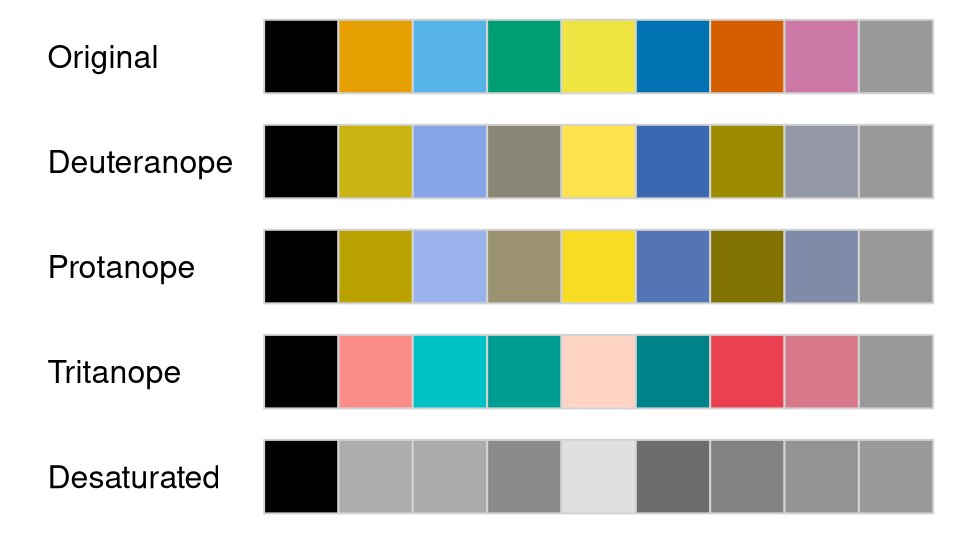
This shows that the Okabe-Ito palette is quite robust under various forms of color vision deficiency, by avoiding pure red or green and by suitably varying chroma and luminance to a certain degree.
Moreover, the cvd argument can be set to a vector of
transformation names, indicating which deficiencies to emulate. In the
example below this is used to compare the Viridis and YlGnBu palettes
under deuteranopia and desaturation.
swatchplot(
"YlGnBu" = sequential_hcl(7, "YlGnBu"),
"Viridis" = sequential_hcl(7, "Viridis"),
cvd = c("deutan", "desaturate"),
nrow = 4
)
HCL (and RGB) spectrum
As the properties of a palette in terms of the perceptual dimensions
hue, chroma, and luminance are not always
clear from looking just at color swatches or (statistical) graphics
based on these palettes, the specplot() function provides
an explicit display for the coordinates of the HCL trajectory associated
with a palette. This can bring out clearly various aspects, e.g.,
whether hue is constant, whether chroma is monotonic or triangular, and
whether luminance is approximately constant (as in many qualitative
palettes), monotonic (as in sequential palettes), or diverging.
The function first transforms a given color palette to its HCL
(polarLUV()) coordinates. As the hues for low-chroma colors
are not (or only poorly) identified, they are smoothed by default. Also,
to avoid jumps from 0 to 360 or vice versa, the hue coordinates are
shifted suitably.
By default, the resulting trajectories in the HCL spectrum are visualized by a simple line plot:
- Hue is drawn in red and coordinates are indicated on the axis on the right with range [-360, 360].
- Chroma is drawn in green with coordinates on the left axis. The range [0, 100] is used unless the palette necessitates higher chroma values.
- Luminance is drawn in blue with coordinates on the left axis in the range [0, 100].
Additionally, a color swatch for the palette is included. Optionally, a second spectrum for the corresponding trajectories of RGB coordinates can be included. However, this is usually just of interest for palettes created in RGB space (or simple transformations of RGB).
The illustrations below show how basic qualitative, sequential, and diverging palettes are constructed in HCL space (the corresponding mathematical equations are provided in the construction details). In the qualitative “Set 2” palette below, the hue traverses the entire color “wheel” (from 0 to 360 degrees) while keeping chroma and luminance (almost) constant (C = 60 and L = 70).
specplot(qualitative_hcl(100, "Set 2"))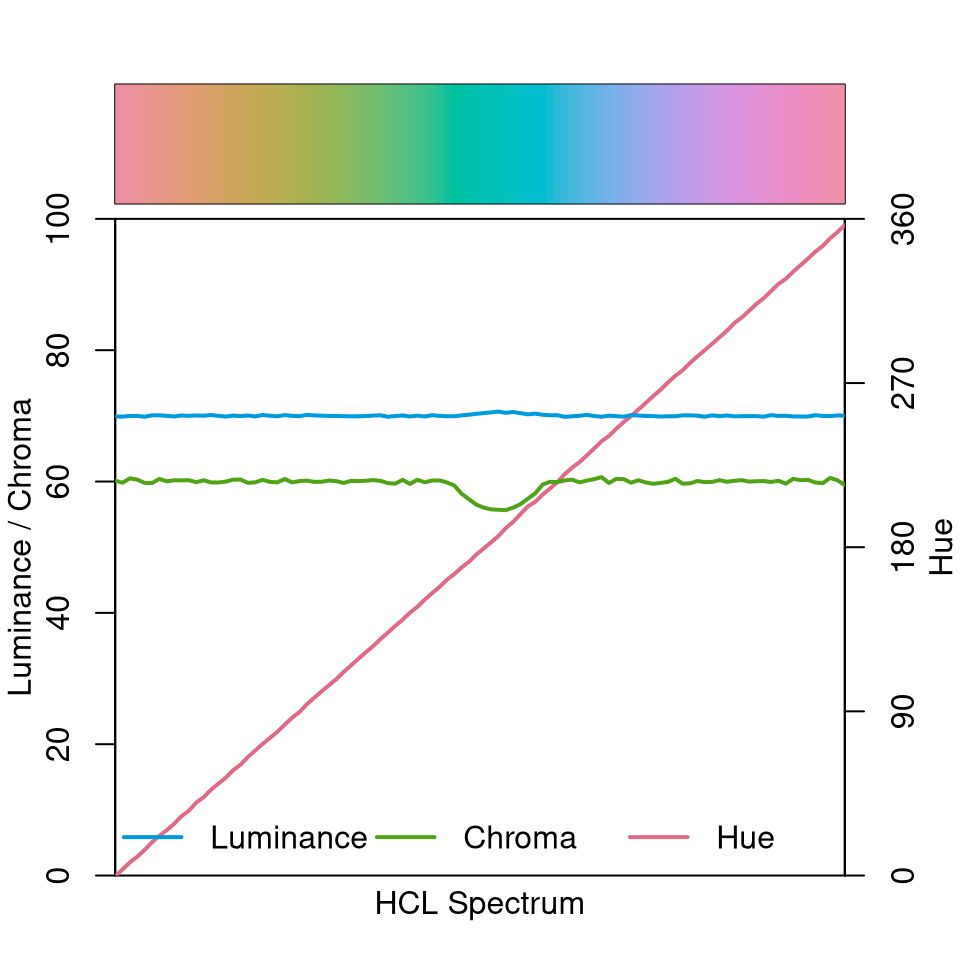
Note that due to the restrictions of the HCL color space, some of the green/blue colors have a slightly smaller maximum chroma resulting in a small dip in the chroma curve. This is fixed automatically (by default) and is hardly noticable in visualizations, though.
The sequential “Blues 2” palette below employs a single hue (H = 260) and a monotonically increasing luminance trajectory (from dark to light). Chroma simply decreases monotonically along with increasing luminance.
specplot(sequential_hcl(100, "Blues 2"))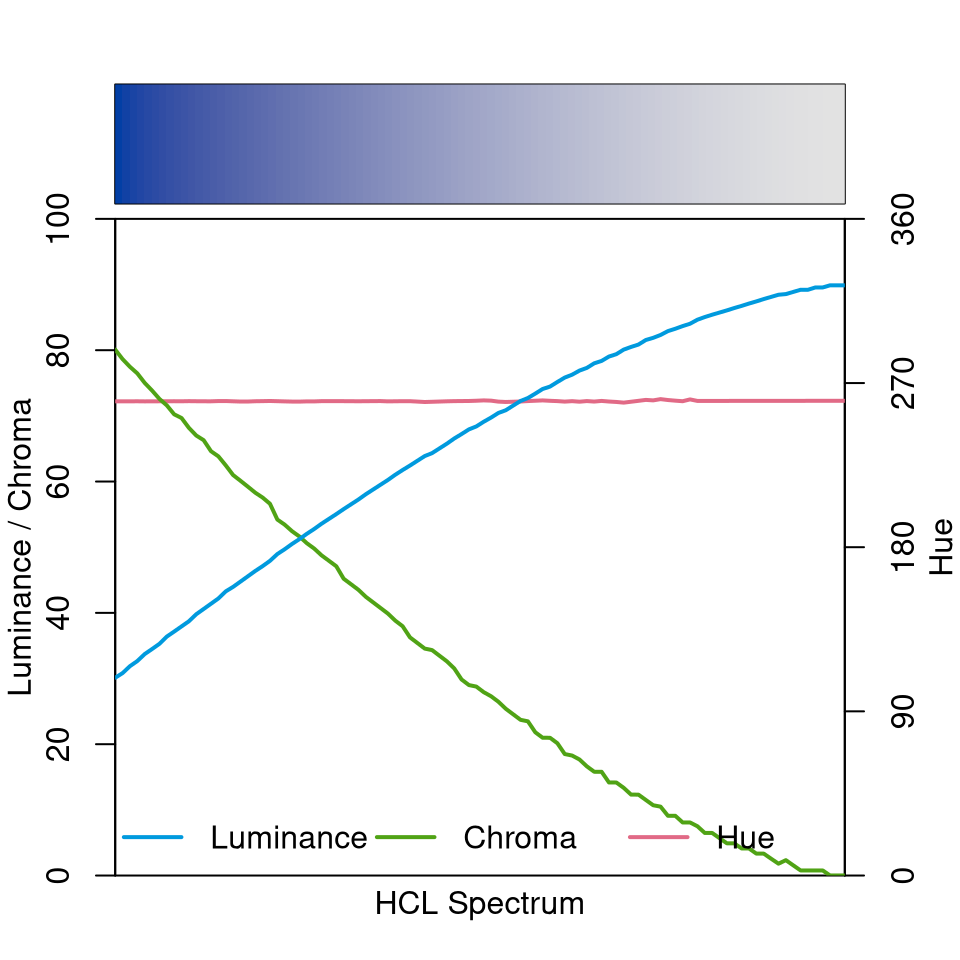
Finally, the diverging “Blue-Red” palette is depicted below. It simply combines a blue and a red sequential single-hue palette (similar to the “Blues 2” palette discussed above). Hue is constant in each “arm” of the palette and the chroma/luminance trajectories are balanced between both arms. In the center the palette passes through a light gray (with zero chroma) as the neutral value.
specplot(diverging_hcl(100, "Blue-Red"))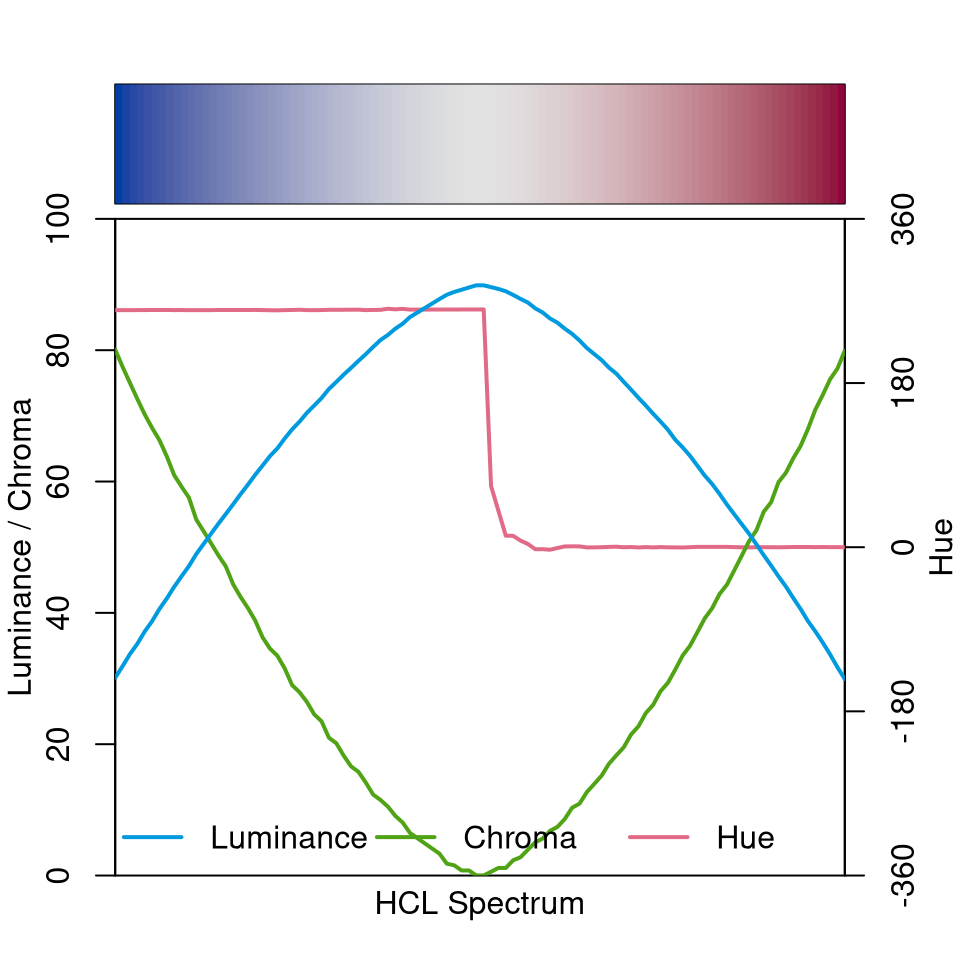
To contrast these well-balanced HCL-based palettes with a poorly-balanced palette, the spectrum of the (in)famous RGB rainbow palette is depicted in both RGB and HCL space.
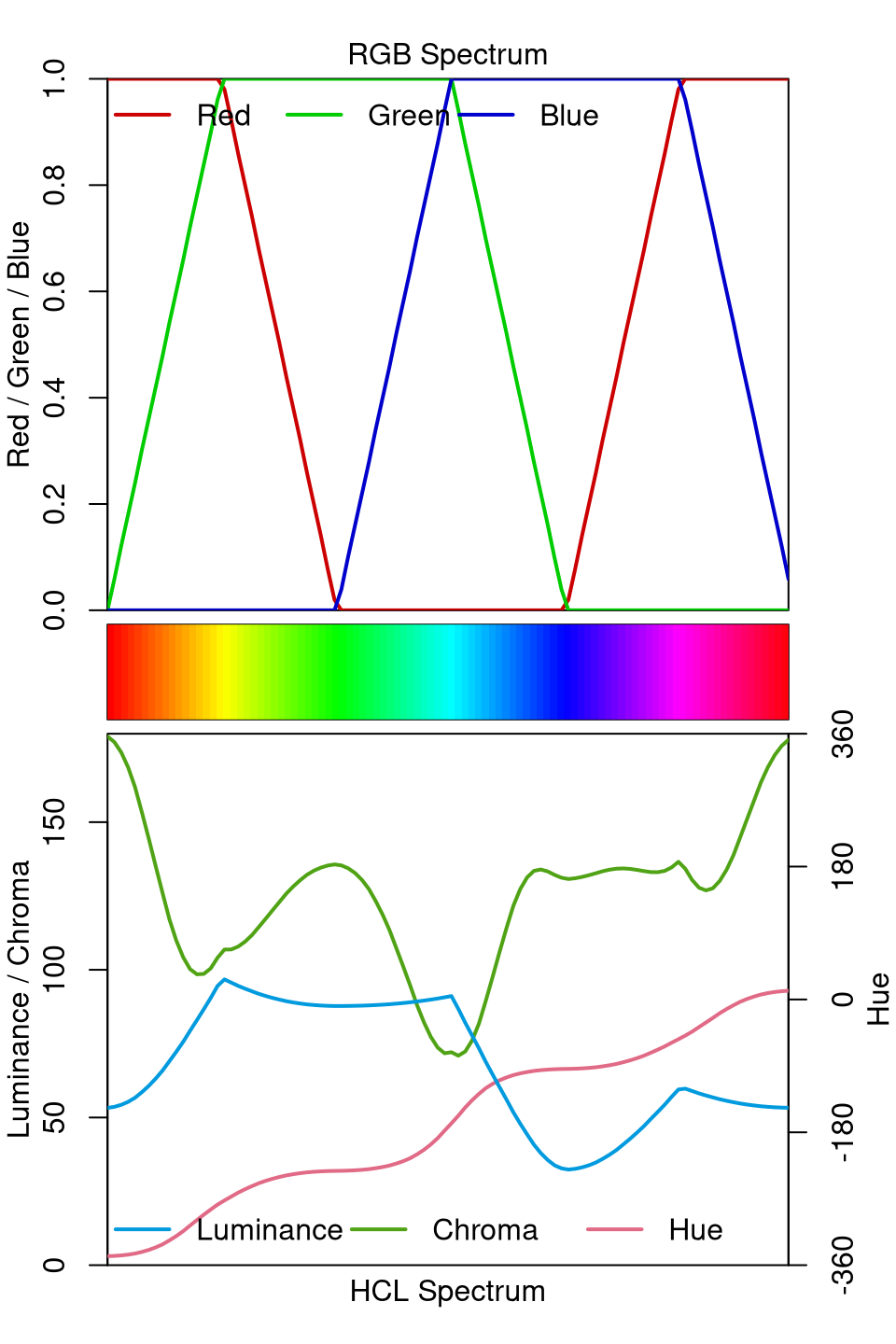
The RGB spectrum shows that the trajectories are quite simple in RGB space but the HCL spectrum shows that the result is very unbalanced with shifts and kinks in both chroma and (more importantly) luminance. This is why this palette is not suitable for encoding underlying data in statistical graphics. See also the related discussion of color vision deficiency.
Trajectories in HCL space
While the specplot() function above works well for
bringing out the HCL coordinates associated with a given palette, it
does not show how the palette fits into the HCL space. For example, it
is not so clear whether high chroma values are close to the maximum
possible for a given hue. Thus, it cannot be easily judged how the
parameters of the hue, chroma, and luminance trajectories can be
modified to obtain another palette.
Therefore, the hclplot() is another visualization of the
HCL coordinates associated with a palette. It does so by collapsing over
one of the coordinates (either the hue H or the luminance L) and
displaying a heatmap of colors combining the remaining two dimensions.
The coordinates for the given color palette are highlighted to bring out
its trajectory. In case the hue is really fixed (as in single-hue
sequential palettes) or the luminance is really fixed (as in the
qualitative palettes), collapsing is straightforward. However, when the
coordinate that is collapsed over is not actually constant in the
palette, a simple bivariate linear model is used to capture how the
collapsed coordinate varies along with the two displayed
coordinates.
The function hclplot() has been designed to work well
with the hcl_palettes() in this package. While it is
possible to apply it to other color palettes as well, the results might
look weird or confusing if these palettes are constructed very
differently (e.g., like the highly saturated base R palettes). To infer
the default type of projection, hclplot()
assesses the luminance trajectory and sets the default
correspondingly:
-
type = "qualitative"if luminance is approximately constant. -
type = "sequential"if luminance is monotonic. -
type = "diverging"if luminance is diverging with two monotonic “arms” in the trajectory.
Thus, for qualitative palettes - where luminance and chroma are fixed - the varying hue is displayed in a projection onto the hue-chroma plane at a given fixed luminance:
hclplot(qualitative_hcl(9, "Dynamic"))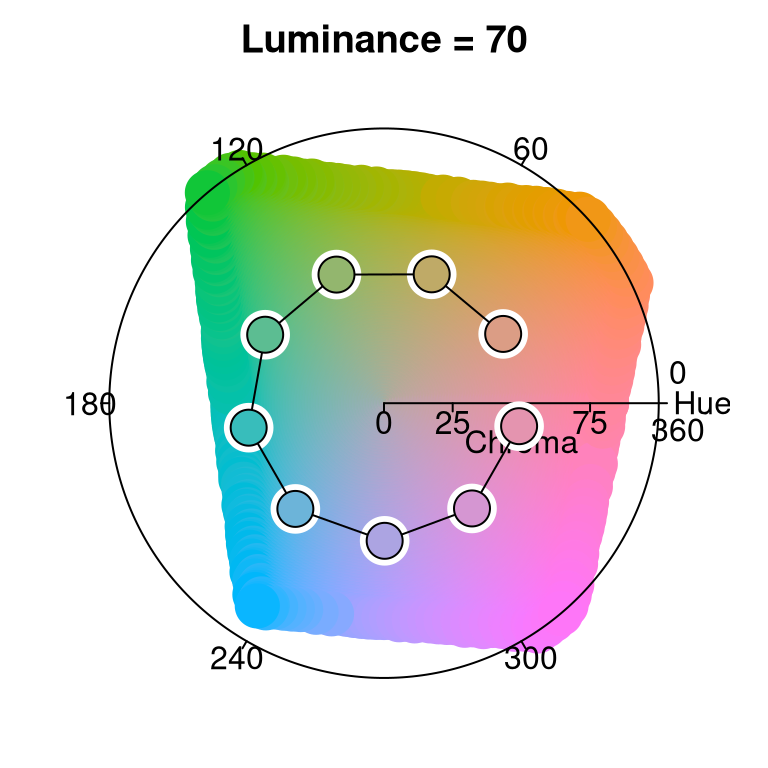
The display below compares three single-hue sequential palettes (similar to “Blues 2” and “Blues 3”) by projection to the luminance-chroma plane for the given fixed hue. In the left panel the hue 260 is used with a simple linear chroma trajectory. The other two panels employ a triangular chroma trajectory for hue 245, either with a piecewise-linear (center) or power-transformed (right) trajectory.
par(mfrow = c(1, 3))
hclplot(sequential_hcl(7, h = 260, c = 80, l = c(35, 95), power = 1))
hclplot(sequential_hcl(7, h = 245, c = c(40, 75, 0), l = c(30, 95), power = 1))
hclplot(sequential_hcl(7, h = 245, c = c(40, 75, 0), l = c(30, 95), power = c(0.8, 1.4)))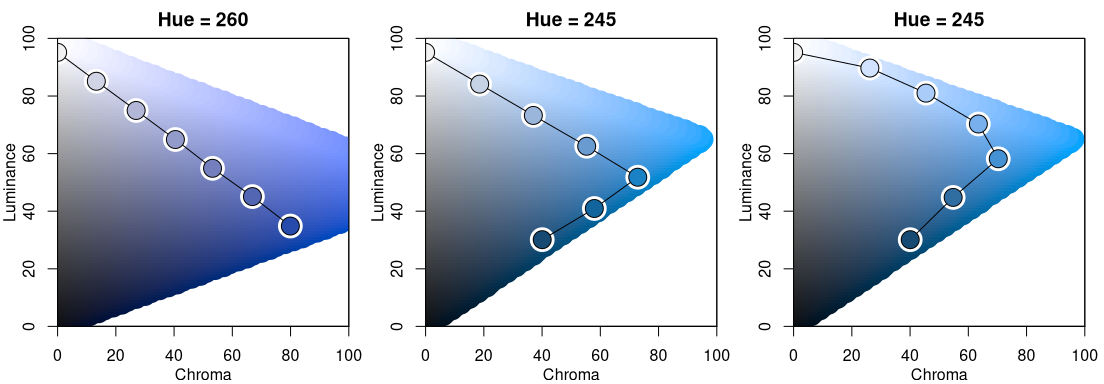
Note that for H = 260 it is possible to go to dark colors (= low luminance) with high chroma while this is not possible to the same extent for H = 245. Hence, chroma has to be decreased when proceeding to the dark low-luminance colors.
Finally, the display below compares two multi-hue sequential palettes along with a diverging palette.
par(mfrow = c(1, 3))
hclplot(sequential_hcl(7, h = c(260, 220), c = c(50, 75, 0), l = c(30, 95), power = 1))
hclplot(sequential_hcl(7, h = c(260, 60), c = 60, l = c(40, 95), power = 1))
hclplot(diverging_hcl(7, h = c(260, 0), c = 80, l = c(35, 95), power = 1))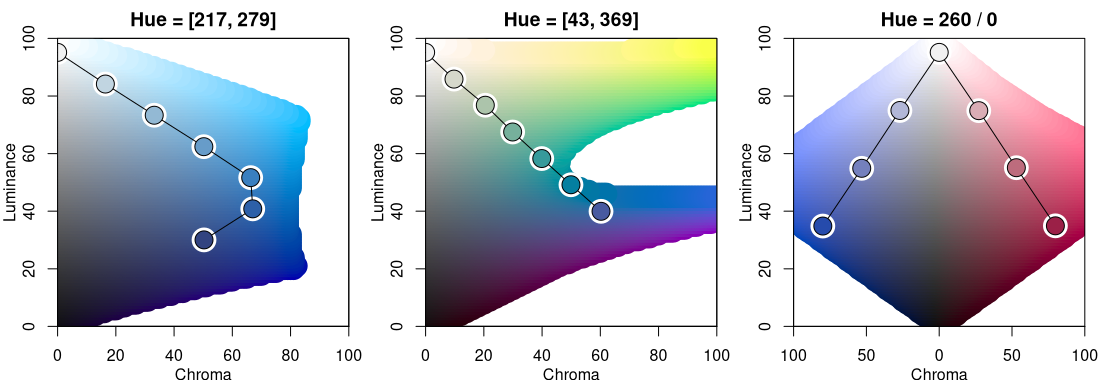
The multi-hue palette on the left employs a small hue range, resulting in a palette of “blues” just with slightly more distinction of the middle colors in the palette. In contrast, the multi-hue “blue-yellow” palette in the center panel uses a large hue range, resulting in more color contrasts throughout the palette. Finally, the balanced diverging palette in the right panel is constructed from two simple single-hue sequential palettes (for hues 260/blue and 0/red) that are completely balanced between the two “arms” of the palette.
Demonstration of statistical graphics
To demonstrate how different kinds of color palettes work in
different kinds of statistical displays, demoplot()
provides a simple convenience interface to some base graphics with
(mostly artificial) data sets. As a first overview, all built-in demos
are displayed with the same sequential heat colors palette:
sequential_hcl(5, "Heat").
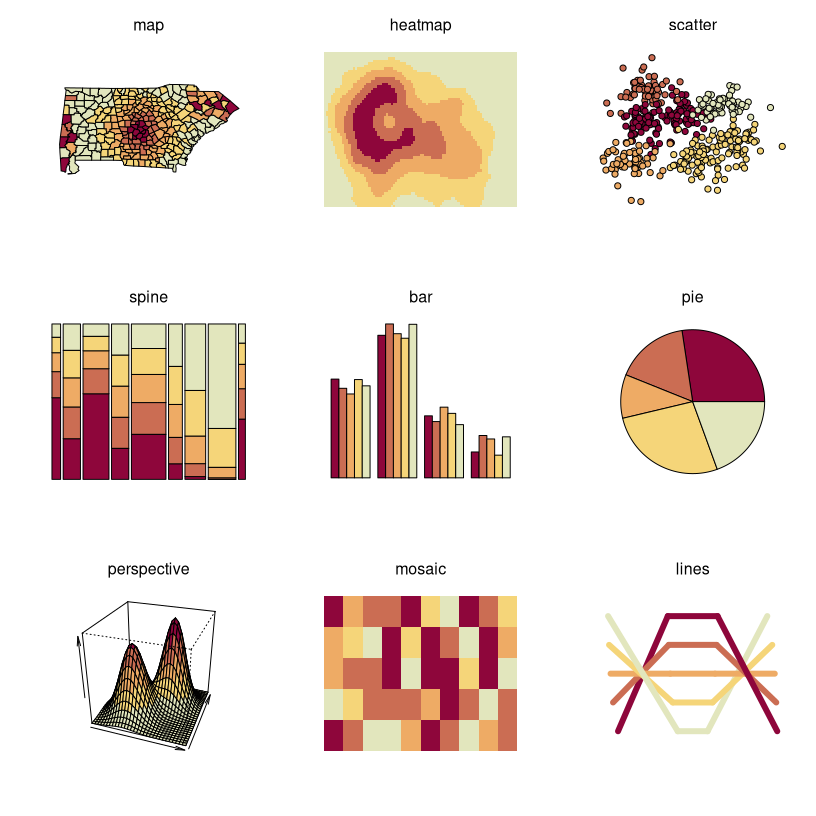
All types of demos can, in principle, deal with arbitrarily many colors from any palette, but the graphics differ in various respects such as:
- Working best for fewer colors (e.g., bar, pie, scatter, lines, …) vs. many colors (e.g., heatmap, perspective, …).
- Intended for categorical data (e.g., bar, pie, …) vs. continuous numeric data (e.g., heatmap, perspective, …).
- Shading areas (e.g., map, bar, pie, …) vs. coloring points or lines (scatter, lines).
Hence, in the following some further illustrations are organized by type of palette, using suitable demos for the particular palettes.
Qualitative palettes: Light pastel colors typically work better for shading areas (pie, left) while darker and more colorful palettes are usually preferred for points (center) or lines (right).
par(mfrow = c(1, 3))
demoplot(qualitative_hcl(4, "Pastel 1"), type = "pie")
demoplot(qualitative_hcl(4, "Set 2"), type = "scatter")
demoplot(qualitative_hcl(4, "Dark 3"), type = "lines")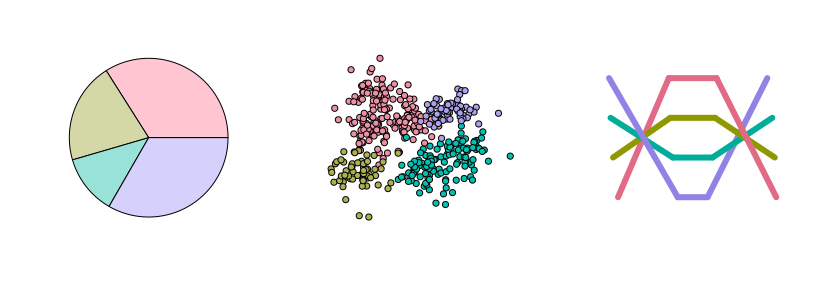
Sequential palettes: Heatmaps (left) or perspective plots (center) often employ almost continuous gradients with strong luminance contrasts. In contrast, when only a few ordered categories are to be displayed (e.g., in a spine plot, right) more colorful sequential palettes like the viridis palette can be useful.
par(mfrow = c(1, 3))
demoplot(sequential_hcl(99, "Purple-Blue"), type = "heatmap")
demoplot(sequential_hcl(99, "Reds"), type = "perspective")
demoplot(sequential_hcl( 4, "Viridis"), type = "spine")
Diverging palettes: In some displays (such as the map, left), it is useful to employ an almost continuous gradient with strong luminance contrast to bring out the extremes. Here, this contrast is amplified by a larger power transformation emphasizing the extremes even further. In contrast, when fewer colors are needed more colorful palettes with lower luminance contrasts can be desired. This is exemplified by a mosaic (center) and bar plot (right).
par(mfrow = c(1, 3))
demoplot(diverging_hcl(99, "Tropic", power = 2.5), type = "map")
demoplot(diverging_hcl( 5, "Green-Orange"), type = "mosaic")
demoplot(diverging_hcl( 5, "Blue-Red 2"), type = "bar")
All displays above focus on palettes designed for light/white backgrounds. Therefore, to conclude, some palettes are highlighted that work well on dark/black backgrounds.
par(mfrow = c(2, 3), bg = "black")
demoplot(sequential_hcl(9, "Oslo"), "heatmap")
demoplot(sequential_hcl(9, "Turku"), "heatmap")
demoplot(sequential_hcl(9, "Inferno", rev = TRUE), "heatmap")
demoplot(qualitative_hcl(9, "Set 2"), "lines")
demoplot(diverging_hcl(9, "Berlin"), "scatter")
demoplot(diverging_hcl(9, "Cyan-Magenta", l2 = 20), "lines")